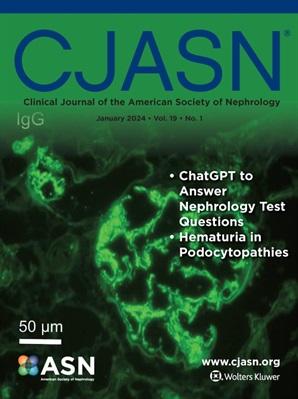New Index Demonstrates Association between Social Vulnerability, Environmental Burden, and Kidney Failure Risk among Individuals with Glomerular Disease.
IF 8.5
1区 医学
Q1 UROLOGY & NEPHROLOGY
Clinical Journal of the American Society of Nephrology
Pub Date : 2025-01-17
DOI:10.2215/cjn.0000000638
引用次数: 0
Abstract
BACKGROUND The Centers for Disease Control and Prevention (CDC) Environmental Justice Index Social-Environmental Ranking (EJI-SER) combines a Social Vulnerability Module (SV) with an Environmental Burden Module (EB) to characterize cumulative environmental and social burden at the census tract level. This analysis evaluates the association between EJI-SER and kidney outcomes in glomerular disease (GD) patients. METHODS Cure Glomerulopathy (CureGN) is an observational cohort study of adults and children with biopsy-proven GD. EJI-SER is a percentile ranking by census tract, with a higher score indicating a more severe burden. Associations between EJI-SER and its components with kidney failure (initiation of kidney replacement therapy, transplant, or two estimated glomerular filtration rates [eGFRs] <15ml/min/1.73m2) and longitudinal eGFR were tested using multivariable Cox regression and linear mixed models, respectively, adjusted for demographics, histologic diagnosis, eGFR and urine protein to creatinine ratio at enrollment, and time from biopsy to enrollment. RESULTS Among 1,149 participants with census tract data, the median (IQR) follow-up was 5.4 (3.0-7.0) years, the median (IQR) age at biopsy was 24 (10-48), and self-identified racial distribution was 5% Asian, 18% Black, and 70% White. Median (IQR) EJI-SER was 0.49 (0.26-0.75). EJI-SER scores in the lowest two quartiles were associated with a lower hazard of kidney failure compared to the highest quartile (adjusted HR [95% CI] 0.62 [0.36-1.08] and 0.43 [0.25-0.76] for EJI-SER 0-25% and >25-50% vs. >75%, respectively) and higher eGFR at enrolllment (adjusted mean 90.1 vs. 87.1 ml/min/1.73m2 for 0-25% vs. >75%, p=0.08). CONCLUSION As captured by EJI-SER, higher environmental and social burdens are associated with lower eGFR and a higher risk of kidney failure in the CureGN cohort. This first use of the EJI-SER in GD demonstrates the need for additional investigation into social drivers of disparities in GD and policies and resources that address these structural inequities.新指标显示肾小球疾病患者的社会脆弱性、环境负担和肾衰竭风险之间的关联
美国疾病控制与预防中心(CDC)环境正义指数社会环境排名(EJI-SER)结合了社会脆弱性模块(SV)和环境负担模块(EB)来表征人口普查区水平的累积环境和社会负担。本分析评估了肾小球疾病(GD)患者EJI-SER与肾脏预后之间的关系。方法:安全性肾小球病(CureGN)是一项观察性队列研究,研究对象为活检证实的GD的成人和儿童。EJI-SER是按人口普查区进行的百分位排名,分数越高表明负担越严重。EJI-SER及其成分与肾衰竭(开始肾脏替代治疗、移植或两次肾小球滤过率[eGFR] 25-50% vs. >75%)和入组时较高的eGFR (0-25% vs. >75%调整后平均90.1 vs. 87.1 ml/min/1.73m2, p=0.08)之间的关联。根据EJI-SER,在CureGN队列中,较高的环境和社会负担与较低的eGFR和较高的肾衰竭风险相关。首次在gdp中使用EJI-SER表明需要进一步调查gdp差异的社会驱动因素以及解决这些结构性不平等的政策和资源。
本文章由计算机程序翻译,如有差异,请以英文原文为准。
求助全文
约1分钟内获得全文
求助全文
来源期刊
CiteScore
12.20
自引率
3.10%
发文量
514
审稿时长
3-6 weeks
期刊介绍:
The Clinical Journal of the American Society of Nephrology strives to establish itself as the foremost authority in communicating and influencing advances in clinical nephrology by (1) swiftly and effectively disseminating pivotal developments in clinical and translational research in nephrology, encompassing innovations in research methods and care delivery; (2) providing context for these advances in relation to future research directions and patient care; and (3) becoming a key voice on issues with potential implications for the clinical practice of nephrology, particularly within the United States. Original manuscript topics cover a range of areas, including Acid/Base and Electrolyte Disorders, Acute Kidney Injury and ICU Nephrology, Chronic Kidney Disease, Clinical Nephrology, Cystic Kidney Disease, Diabetes and the Kidney, Genetics, Geriatric and Palliative Nephrology, Glomerular and Tubulointerstitial Diseases, Hypertension, Maintenance Dialysis, Mineral Metabolism, Nephrolithiasis, and Transplantation.

 求助内容:
求助内容: 应助结果提醒方式:
应助结果提醒方式:


